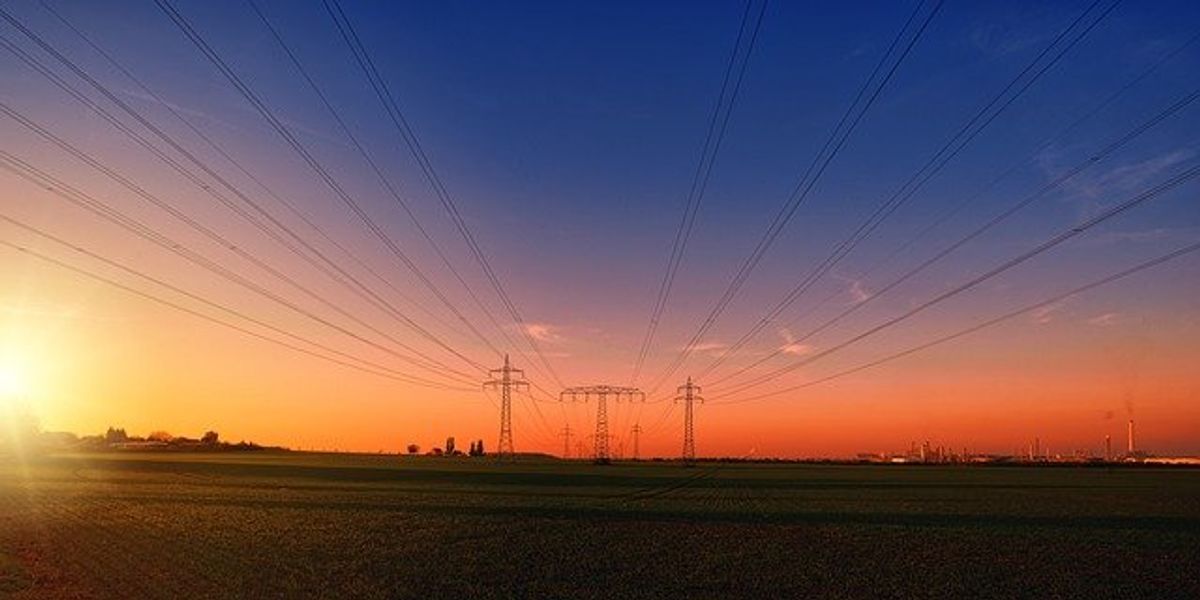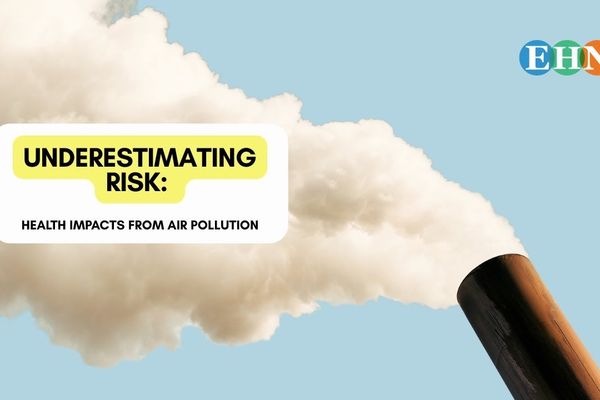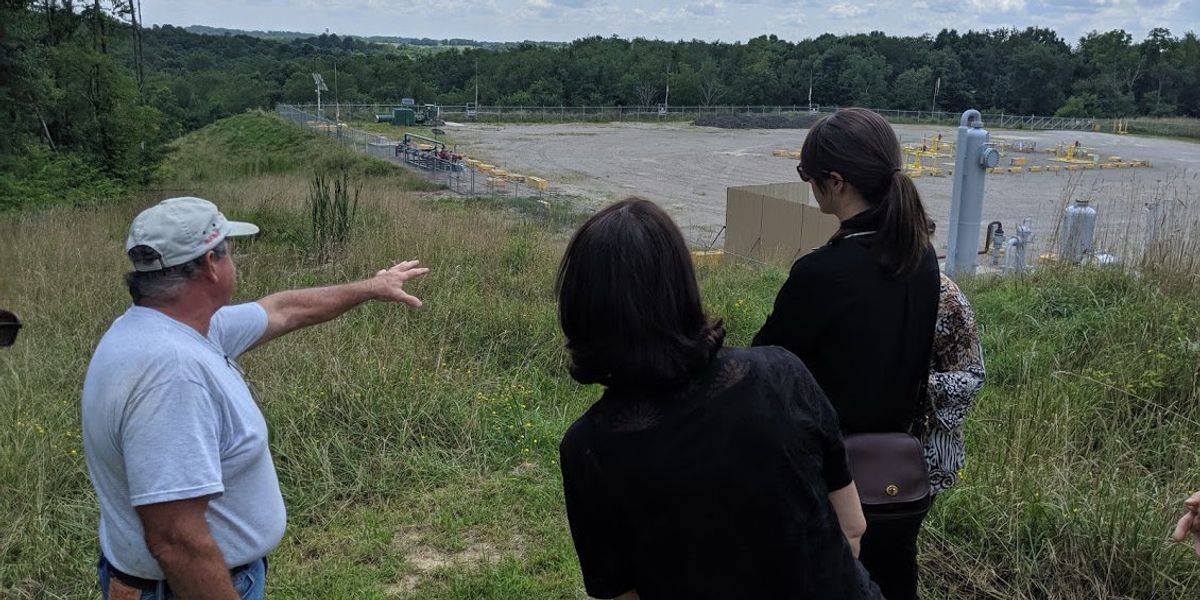
Oil and gas methane emissions in US are at least 15% higher than we thought
An unprecedented analysis from Pennsylvania uncovers flaws in national data
Methane emissions are vastly undercounted at the state and national level because we're missing accidental leaks from oil and gas wells, according to a new study.
Methane is a greenhouse gas that, when initially released, is about 87 times more potent than carbon dioxide at driving global warming (it doesn't last as long in the atmosphere, however, so when averaged over a century methane is about 30 times more potent than carbon dioxide at driving global warming). Methane causes about 25 percent of human-driven climate change according to the Environmental Defense Fund, and the oil and gas industry is the leading emitter of methane. Last year, global atmospheric methane reached a 20-year high.
The new study, conducted by researchers at Cornell University and published in the journal Environmental Science and Technology, looked at 589,175 operator reports on methane leaks from both fracking and conventional oil and gas wells in Pennsylvania from 2014-2018. The researchers found that methane emissions in the state are at least 15 percent higher than previously thought—and they believe a similar under-counting is happening at the national level.
"Another 15 percent of methane going into the atmosphere that we didn't know about is very significant for climate change in the short term," Tony Ingraffea, professor emeritus of engineering at Cornell and the study's lead author, told EHN.
Ingraffea also authored a groundbreaking study in 2011 that determined methane emissions from fracking accelerate global warming more than carbon dioxide emissions from either coal or conventional oil and gas. Pennsylvania is the second largest producer of natural gas in the country after Texas. Ingraffea's study comes on the heels of a study published this week by Harvard researchers that found methane emissions in the Permian basin in Texas and New Mexico are more than two times higher than federal estimates.
Methane exposure is rarely a threat to human health except under extreme circumstances, but "as a climate change exacerbator," Ingraffea said, "it affects the health of every human on the planet."
The Pennsylvania Department of Environmental Protection (PA DEP) has required all oil and gas well operators in the state to measure the amount of methane leaking from producing wells once per quarter since 2014. Fracking wells are required to submit quarterly reports on their findings, while conventional wells must submit reports at least once a year. No other state has such extensive methane leak monitoring, and this study, which took three years to complete, marks the first time the data has ever been analyzed.
While other studies have estimated methane leaks from oil and gas, such as flying over gas wells in aircrafts with methane detection equipment, this is the first to use data that's been self-reported by oil and gas well operators.
"This is a profoundly important database," Ingraffea said. "There's nothing comparable happening in any other part of America."
Ingraffea and his colleagues found that the Pennsylvania oil and gas wells that reported methane leaks over the five year period emitted an average of about 56 gigagrams (or 56 billion grams) of methane into the atmosphere every year. These emissions are not currently included in the state's methane emissions inventory.
PA DEP director of communications Neil Shader told EHN the agency is still reviewing the study's findings and can't yet speculate about what actions it may take in response.
A series of studies conducted by the Environmental Defense Fund previously estimated that around 10 teragrams (or 10 trillion grams) of methane are leaking from the oil and gas sector across the country each year. "The amount of methane coming from leaks in Pennsylvania is a relatively small subset of that," Ingraffea said. "But if we take a wild guess and extrapolate what we're seeing in Pennsylvania to all of America, we're looking at three million wells and 20 times the methane emissions we saw in the Pennsylvania data."
Meanwhile, the Trump Administration has proposed rolling back existing methane regulations at the federal level through the U.S. Environmental Protection Agency (EPA). The EPA's rule, which is not yet finalized, aims to lift rules from the Obama Administration that required companies to detect and fix methane leaks. In a statement, EPA Administrator said the revisions would remove "unnecessary and duplicative regulatory burdens from the oil and gas industry."
"EPA is moving in the wrong direction," Ingraffea said, adding that a major part of the problem is a failure to accurately measure our current methane emissions.
"Missing 10 to 15 percent of methane emissions would be like saying we're off about carbon dioxide emissions by factor of two," he added. "No one would accept that. Everyone would be saying, 'We're in big trouble.' Being off this much in our methane accounting is just as important."
Unreliable reporting
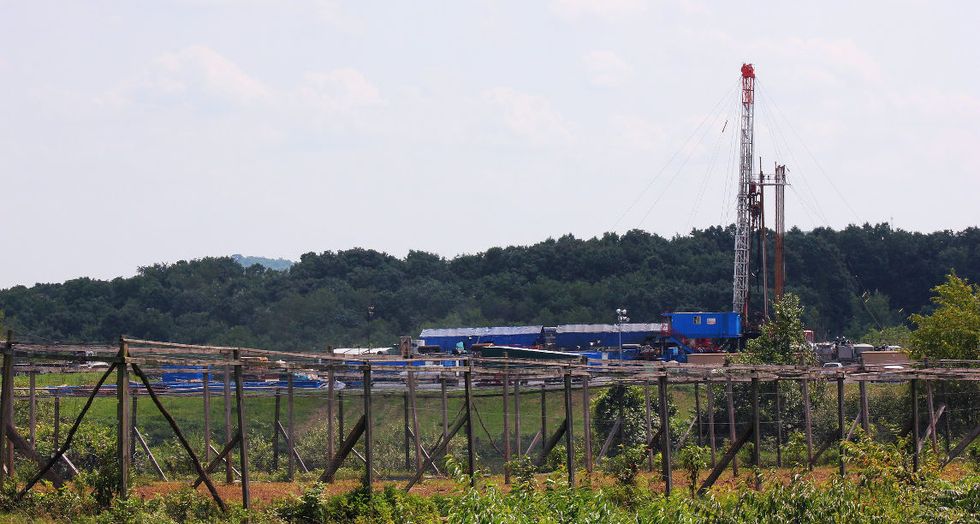
Marcellus Shale rig and gas well operation in Jackson Township, Pennsylvania. (Credit: WCN 24/7/flickr)
Ingraffea noted that their calculations are likely on the low end of true methane emissions from oil and gas well leaks in Pennsylvania.
There are around 132,000 operating oil and gas wells in the state, but fewer than half of those reported data on methane leaks to the PA DEP as required. Of the some 60,000 wells that submitted reports, about half of those didn't actually include any data, citing various reasons they couldn't take measurements on methane leaks (like inability to access the well site). The study also only looked at data from wells that are actively producing—it didn't account for methane leaks from abandoned wells or wells that were still being actively drilled or fracked (and not yet producing).
Shader said that the wells missing data are conventional wells, not fracking wells, and include things like home-use wells and wells from small operators. "DEP often receives data from these operators on paper, and it must be entered manually, which can cause delays in making the data available electronically," he said, "however, DEP has and will continue to take enforcement actions against operators that do not comply with the reporting requirements."
The Pennsylvania Independent Oil & Gas Association (PIOGA) declined to comment on whether the industry is working to resolve these issues with reporting.
The researchers also noted some major issues with the reliability of the data. For example, some wells that reported large quantities of methane leaks for several years in a row would suddenly report none after being purchased by a different operator the following year. One likely reason for this is a lack of consistency in testing techniques, Ingraffea said. Operators aren't all required to use the same testing equipment or methods.
"Not only is much of the data unreliable," he said, "but I will go on record as saying that some of the data being reported to the state is downright fraudulent."
There's also no minimum reporting requirement, so some operators would note that the emissions were too low to report, but the researchers have no way of knowing what threshold they used to determine that. All of these factors likely mean the reported emissions the researchers analyzed are underestimates.
Ingraffea said there should be a requirement to measure and report on methane leaks in a consistent manner and "super emitters" should be targeted and required to fix leaking equipment.
"Most wells aren't leaking," he said. "If they're operating correctly, they shouldn't leak. Maybe just 10 percent of all unconventional wells are leaking, for example, but they're not all leaking the same amount, either. Some leak just a little, and some, the super emitters, leak like sieves. DEP should require those to be fixed."
Many of those super emitters are coalbed methane wells, most of which are located in the Southwestern part of the state where a majority of the state's fracking also occurs.
"DEP is also concerned with these 'super emitters,' Shader said, "and is exploring ways to identify them, as well as being interested in suggestions for identifying them."
He added that DEP is aware that methane leaks are also a problem at abandoned wells (which were not looked at as part of the Cornell study), but that the agency "has very few resources to devote to plugging," and hopes initiatives like Governor Wolf's Restore PA initiative, which would provide funding for critical state infrastructure including plugging abandoned wells, will help address the leaks.
Lack of regulations, lack of accounting
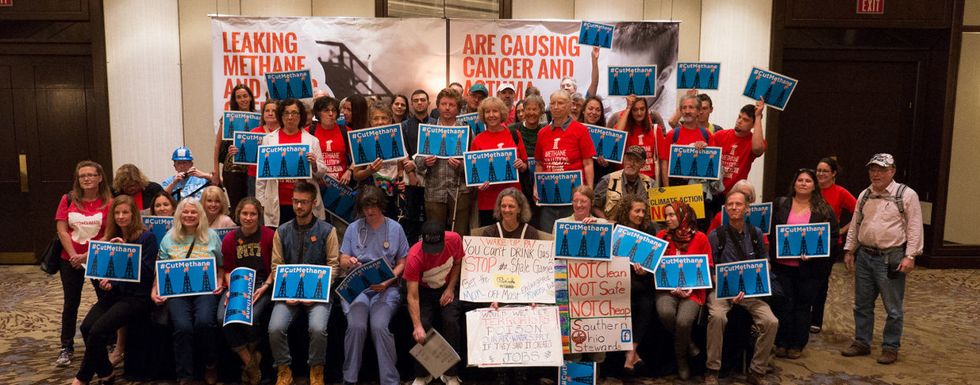
Rally and testimonies regarding the EPA hearing on methane emissions in Pittsburgh in 2015. (Credit: Mark Dixon/flickr)
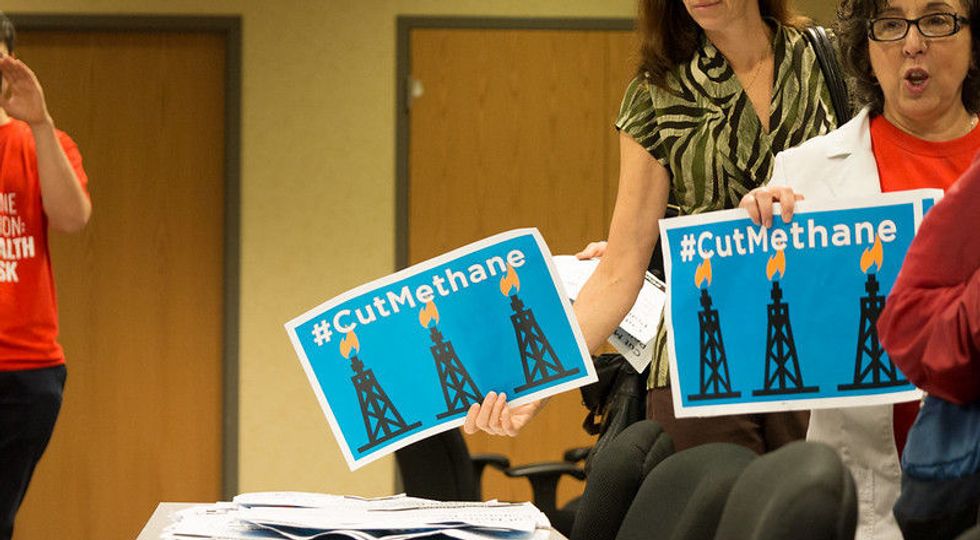
(Credit: Mark Dixon/flickr)
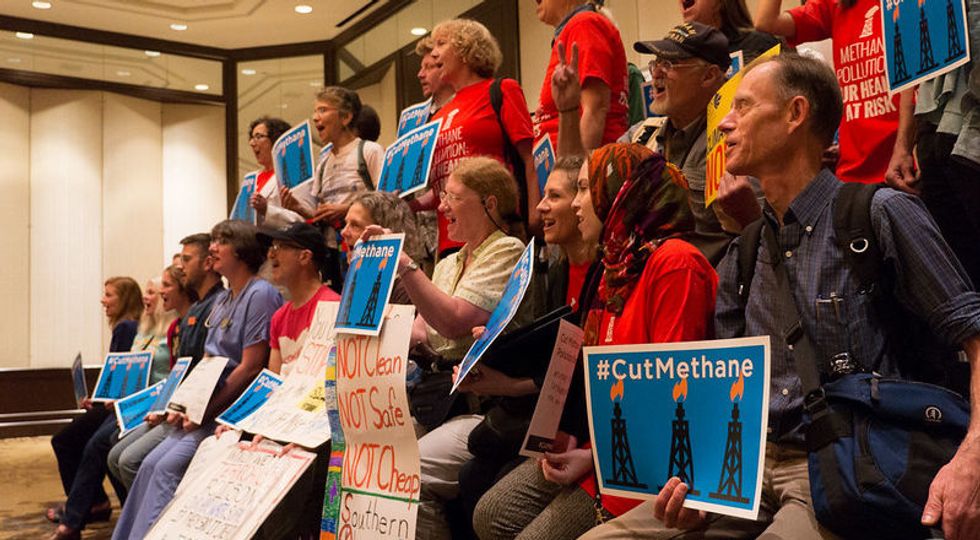
Credit: Mark Dixon/flickr)
In December, Pennsylvania's Environmental Quality Board voted in favor of a new set of regulations aimed at reducing emissions of volatile organic compounds (VOC) like benzene, toluene, and other chemicals linked to cancer and other health effects from fracking sites. The rule is slated to be enacted following a 60-day public comment period, which the PA DEP said is expected to occur sometime this year, "likely next month."
Governor Tom Wolf's office, which drafted the regulations, claimed the new rule would also indirectly reduce methane emissions by more than 75,000 tons (about 68 gigagrams) per year, but environmental advocates expressed frustration that the rule doesn't directly address methane leaks.
"We have known for years that PA DEP's emissions inventory, which relies on industry-reported data, significantly understates the actual emissions coming from the Pennsylvania oil and gas sector," Joseph Otis Minott, executive director and chief counsel for Philadelphia-based advocacy group Clean Air Council, told EHN. "We are encouraged to see that DEP estimates its proposed existing source rule will reduce over 75,600 [tons per year] of methane emissions and would respectfully urge the Department to open a public comment period on the proposal as soon as possible."
Ingraffea said there have been "hundreds of reports and papers looking at methane emissions published since my first paper came out in 2011...and the scientific consensus is that what EPA is reporting to all of us, and to Congress, and to the President significantly underestimates the actual methane emissions from the oil and gas industry."
Banner photo: Residents of Southwestern Pennsylvania tour a producing fracking well pad. (Credit: Kristina Marusic/EHN)
Editor's note: The story has been updated to clarify Pennsylvania's annual methane leak reporting requirements.








